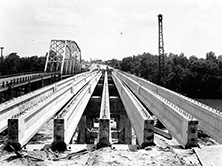 James H. Clark Bridge (Bladen County Bridge 17) under construction in 1957 over the Cape Fear River at Elizabethtown — one of the State Highway Commission’s first uses of prestressed concrete I beams or stringer/multi beams. (Courtesy of The State Archives of North Carolina)
James H. Clark Bridge (Bladen County Bridge 17) under construction in 1957 over the Cape Fear River at Elizabethtown — one of the State Highway Commission’s first uses of prestressed concrete I beams or stringer/multi beams. (Courtesy of The State Archives of North Carolina) In the mid-1950s the North Carolina State Highway Commission introduced a new material that was to have a profound impact on its bridge building practices and eventually become a dominant material of the late 20th and early 21st centuries.
Prestressed concrete is internally stressed in compression, usually by high-strength steel wires or cables, to counterbalance the stresses from bending caused by loads. The engineer can make the compressive forces induced into the beam equal to the stresses expected from the weight of the bridge and its traffic, thus counteracting the tendency of concrete to develop cracks from flexing.
It is a highly economical use of material. The beams can be precast in large numbers of like structural elements under controlled conditions in casting yards with savings in forms and falsework, elimination of on-the-job labor, speed of construction, and closer control of concrete mix.
The beams can be cast in I-shapes, T-shapes, hollow boxes, slabs and channels. Almost all of these shapes, and a variety of methods for inducing tension in the beams, made their first appearance nationally in the 1950s. As with many new technologies, prestressed concrete went through a period of trial and error before becoming a mostly standardized product.
Prestressed concrete was developed in Europe in the early 20th century, but did not make its appearance in the United States until the Walnut Lane Bridge in Philadelphia, begun in 1949 and completed in 1951, which was built with the assistance of Belgian engineers. Following construction of that bridge, which received extensive coverage in the national engineering press, many American engineers began to look for ways to apply the new material.
Several state highway departments, most notably Pennsylvania and Florida, led the way. By the mid- to late-1950s, North Carolina was among the many using prestressed concrete for a variety of bridge types such as channel beam and stringer.